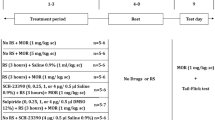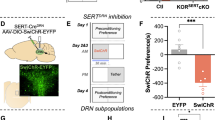Abstract
Rationale
Exposure to a single session of uncontrollable inescapable shock (IS), but not to identical controllable escapable shock, produces a potentiation of morphine's rewarding properties that is unusual in that the stressor can be given a number of days before the drug administration in an environment quite different from the drug context. Many other behavioral outcomes of stressors that depend on the uncontrollability of the stressor are mediated by alterations in serotonergic (5-HT) neurons within the dorsal raphe nucleus (DRN).
Objectives
The present experiments examined the role of the DRN and 5-HT in mediating the effect of IS on the rewarding properties of morphine as assessed by conditioned place preference (CPP).
Methods
In experiment 1, subjects received small electrolytic lesions of the DRN and were tested for morphine (3.0 mg/kg, SC) CPP after IS or control treatment. In experiment 2, subjects received an intra-DRN microinjection of the 5-HT1A agonist 8-hydroxy-2-(di-n-propylamino)tetralin (8-OH-DPAT, 1.0 μg/0.5 μl) either before IS or before morphine (3.0 mg/kg, SC) injections during CPP testing.
Results
IS potentiated morphine CPP in controls, but both DRN lesion and intra-DRN 8-OH-DPAT, either before IS or before morphine administration, completely blocked this effect.
Conclusions
These data implicate alterations in DRN 5-HT neurons in the potentiation of morphine reward produced by uncontrollable stress.




Similar content being viewed by others
References
Adell A, Celada P, Abellan MT, Artigas F (2002) Origin and functional role of the extracellular serotonin in the midbrain raphe nuclei. Brain Res Brain Res Rev 39:154–180
Aghajanian GK, Lakoski JM (1984) Hyperpolarization of serotonergic neurons by serotonin and LSD: studies in brain slices showing increased K+ conductance. Brain Res 305:181–185
Amat J, Matus-Amat P, Watkins LR, Maier SF (1998a) Escapable and inescapable stress differentially alter extracellular levels of 5-HT in the basolateral amygdala of the rat. Brain Res 812:113–120
Amat J, Matus-Amat P, Watkins LR, Maier SF (1998b) Escapable and inescapable stress differentially and selectively alter extracellular levels of 5-HT in the ventral hippocampus and dorsal periaqueductal gray of the rat. Brain Res 797:12–22
Anisman H, Zacharko RM (1986) Behavioral and neurochemical consequences associated with stressors. Ann NY Acad Sci 467:205–225
Anisman H, Zalcman S, Shanks N, Zacharko RM (1991) Multisystem regulation of performance deficits induced by stressors: an animal model of depression. In: Boulton AA, Baker GB, Martin-Iverson MT (eds) Animal models in psychiatry, II. Humana Press, Clifton, N.J., pp 1–59
Bassareo V, Tanda G, Petromilli P, Giua C, Di Chiara G (1996) Non-psychostimulant drugs of abuse and anxiogenic drugs activate with differential selectivity dopamine transmission in the nucleus accumbens and in the medial prefrontal cortex of the rat. Psychopharmacology 124:293–299
Bonvento G, Scatton B, Claustre Y, Rouquier L (1992) Effect of local injection of 8-OH-DPAT into the dorsal or median raphe nuclei on extracellular levels of serotonin in serotonergic projection areas in the rat brain. Neurosci Lett 137:101–104
Carboni E, Acquas E, Frau R, Di Chiara G (1989a) Differential inhibitory effects of a 5-HT3 antagonist on drug-induced stimulation of dopamine release. Eur J Pharmacol 164:515–519
Carboni E, Acquas E, Leone P, Di Chiara G (1989b) 5HT3 receptor antagonists block morphine- and nicotine- but not amphetamine-induced reward. Psychopharmacology 97:175–178
De Deurwaerdere P, Stinus L, Spampinato U (1998) Opposite change of in vivo dopamine release in the rat nucleus accumbens and striatum that follows electrical stimulation of dorsal raphe nucleus: role of 5-HT3 receptors. J Neurosci 18:6528–6538
Goeders NE, Guerin GF (1994) Non-contingent electric footshock facilitates the acquisition of intravenous cocaine self-administration in rats. Psychopharmacology 114:63–70
Grahn RE, Will MJ, Hammack SE, Maswood S, McQueen MB, Watkins LR, Maier SF (1999) Activation of serotonin-immunoreactive cells in the dorsal raphe nucleus in rats exposed to an uncontrollable stressor. Brain Res 826:35–43
Helmreich DL, Watkins LR, Deak T, Maier SF, Akil H, Watson SJ (1999) The effect of stressor controllability on stress-induced neuropeptide mRNA expression within the paraventricular nucleus of the hypothalamus. J Neuroendocrinol 11:121–128
Higgins GA, Joharchi N, Nguyen P, Sellers EM (1992) Effect of the 5-HT3 receptor antagonists, MDL72222 and ondansetron on morphine place conditioning. Psychopharmacology 106:315–320
Hyson RL, Ashcraft LJ, Drugan RC, Grau JW, Maier SF (1982) Extent and control of shock affects naltrexone sensitivity of stress-induced analgesia and reactivity to morphine. Pharmacol Biochem Behav 17:1019–1025
Iyer RN, Bradberry CW (1996) Serotonin-mediated increase in prefrontal cortex dopamine release: pharmacological characterization. J Pharmacol Exp Ther 277:40–47
Jolas T, Aghajanian GK (1997) Opioids suppress spontaneous and NMDA-induced inhibitory postsynaptic currents in the dorsal raphe nucleus of the rat in vitro. Brain Res 755:229–245
Kia HK, Miquel MC, Brisorgueil MJ, Daval G, Riad M, El Mestikawy S, Hamon M, Verge D (1996) Immunocytochemical localization of serotonin1A receptors in the rat central nervous system. J Comp Neurol 365:289–305
Maier SF, Seligman MEP (1976) Learned helplessness: theory and evidence. J Exp Psychol [Gen Sect] 105:3–46
Maier SF, Ryan SM, Barksdale CM, Kalin NH (1986) Stressor controllability and the pituitary-adrenal system. Behav Neurosci 100:669–674
Maier SF, Grahn RE, Kalman BA, Sutton LC, Wiertelak EP, Watkins LR (1993) The role of the amygdala and dorsal raphe nucleus in mediating the behavioral consequences of inescapable shock. Behav Neurosci 107:377–388
Maier SF, Kalman BA, Grahn RE (1994) Chlordiazepoxide microinjected into the region of the dorsal raphe nucleus eliminates the interference with escape responding produced by inescapable shock whether administered before inescapable shock or escape testing. Behav Neurosci 108:121–130
Maier SF, Busch CR, Maswood S, Grahn RE, Watkins LR (1995a) The dorsal raphe nucleus is a site of action mediating the behavioral effects of the benzodiazepine receptor inverse agonist DMCM. Behav Neurosci 109:759–766
Maier SF, Grahn RE, Watkins LR (1995b) 8-OH-DPAT microinjected in the region of the dorsal raphe nucleus blocks and reverses the enhancement of fear conditioning and interference with escape produced by exposure to inescapable shock. Behav Neurosci 109:404–412
Maswood S, Barter JE, Watkins LR, Maier SF (1998) Exposure to inescapable but not escapable shock increases extracellular levels of 5-HT in the dorsal raphe nucleus of the rat. Brain Res 783:115–120
McNeish CS, Svingos AL, Hitzemann R, Strecker RE (1993) The 5-HT3 antagonist zacopride attenuates cocaine-induced increases in extracellular dopamine in rat nucleus accumbens. Pharmacol Biochem Behav 45:759–763
Paxinos G, Watson C (1986) The rat brain in stereotaxic coordinates. Academic Press, New York
Pehek EA, McFarlane HG, Maguschak K, Price B, Pluto CP (2001) M100,907, a selective 5-HT(2A) antagonist, attenuates dopamine release in the rat medial prefrontal cortex. Brain Res 888:51–59
Pei Q, Zetterstrom T, Leslie RA, Grahame-Smith DG (1993) 5-HT3 receptor antagonists inhibit morphine-induced stimulation of mesolimbic dopamine release and function in the rat. Eur J Pharmacol 230:63–68
Penington NJ, Reiffenstein RJ (1986) Direct comparison of hallucinogenic phenethylamines and d-amphetamine on dorsal raphe neurons. Eur J Pharmacol 122:373–377
Petty F, Sherman AD (1981) GABAergic modulation of learned helplessness. Pharmacol Biochem Behav 15:567–570
Petty F, Kramer G, Wilson L (1992) Prevention of learned helplessness: in vivo correlation with cortical serotonin. Pharmacol Biochem Behav 43:361–367
Phelix CF, Broderick PA (1995) Light microscopic immunocytochemical evidence of converging serotonin and dopamine terminals in ventrolateral nucleus accumbens. Brain Res Bull 37:37–40
Rebec GV, Curtis SD (1983) Reciprocal changes in the firing rate of neostriatal and dorsal raphe neurons following local infusions or systemic injections of d-amphetamine: evidence for neostriatal heterogeneity. J Neurosci 3:2240–2250
Sotelo C, Cholley B, El Mestikawy S, Gozlan H, Hamon M (1990) Direct immunohistochemical evidence of the existence of 5-HT1A autoreceptors on serotonergic neurons in the midbrain raphe nuclei. Eur J Neurosci 2:1144–1154
Sprouse JS, Aghajanian GK (1987) Electrophysiological responses of serotonergic dorsal raphe neurons to 5-HT1A and 5-HT1B agonists. Synapse 1:3–9
Spyraki C, Nomikos GG, Galanopoulou P, Daifotis Z (1988) Drug-induced place preference in rats with 5,7-dihydroxytryptamine lesions of the nucleus accumbens. Behav Brain Res 29:127–134
Steinbusch HW (1981) Distribution of serotonin-immunoreactivity in the central nervous system of the rat-cell bodies and terminals. Neuroscience 6:557–618
Tanda G, Frau R, Di Chiara G (1995) Local 5HT3 receptors mediate fluoxetine but not desipramine-induced increase of extracellular dopamine in the prefrontal cortex. Psychopharmacology 119:15–19
Tao R, Auerbach SB (1995) Involvement of the dorsal raphe but not median raphe nucleus in morphine-induced increases in serotonin release in the rat forebrain. Neuroscience 68:553–561
Tao R, Auerbach SB (2000) Regulation of serotonin release by GABA and excitatory amino acids. J Psychopharmacol 14:100–113
Tao R, Ma Z, Auerbach SB (1996) Differential regulation of 5-hydroxytryptamine release by GABAA and GABAB receptors in midbrain raphe nuclei and forebrain of rats. Br J Pharmacol 119:1375–1384
Tzschentke TM (1998) Measuring reward with the conditioned place preference paradigm: a comprehensive review of drug effects, recent progress and new issues. Prog Neurobiol 56:613–672
Van Bockstaele EJ, Biswas A, Pickel VM (1993) Topography of serotonin neurons in the dorsal raphe nucleus that send axon collaterals to the rat prefrontal cortex and nucleus accumbens. Brain Res 624:188–198
Vertes RP (1991) A PHA-L analysis of ascending projections of the dorsal raphe nucleus in the rat. J Comp Neurol 313:643–668
Weiss JM, Goodman PA, Losito BA, Corrigan S, Charry JM, Bailey WH (1981) Behavioral depression produced by an uncontrollable stressor: relationship to norepinephrine, dopamine, and serotonin levels in various regions of rat brain. Brain Res Rev 3:167–205
Will MJ, Watkins LR, Maier SF (1998) Uncontrollable stress potentiates morphine's rewarding properties. Pharmacol Biochem Behav 60:655–664
Will MJ, Der-Avakian A, Pepin JL, Durkan BT, Watkins LR, Maier SF (2002) Modulation of the locomotor properties of morphine and amphetamine by uncontrollable stress. Pharmacol Biochem Behav 71:345–351
Yoshimoto K, McBride WJ (1992) Regulation of nucleus accumbens dopamine release by the dorsal raphe nucleus in the rat. Neurochem Res 17:401–407
Yoshimoto K, Yayama K, Sorimachi Y, Tani J, Ogata M, Nishimura A, Yoshida T, Ueda S, Komura S (1996) Possibility of 5-HT3 receptor involvement in alcohol dependence: a microdialysis study of nucleus accumbens dopamine and serotonin release in rats with chronic alcohol consumption. Alcohol Clin Exp Res 20:311A–319A
Acknowledgements
This research was supported by NIDA grant DA13159.
Author information
Authors and Affiliations
Corresponding author
Rights and permissions
About this article
Cite this article
Will, M.J., Der-Avakian, A., Bland, S.T. et al. Electrolytic lesions and pharmacological inhibition of the dorsal raphe nucleus prevent stressor potentiation of morphine conditioned place preference in rats. Psychopharmacology 171, 191–198 (2004). https://doi.org/10.1007/s00213-003-1572-1
Received:
Accepted:
Published:
Issue Date:
DOI: https://doi.org/10.1007/s00213-003-1572-1




